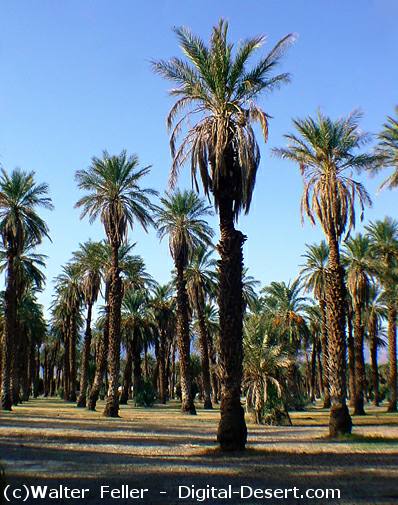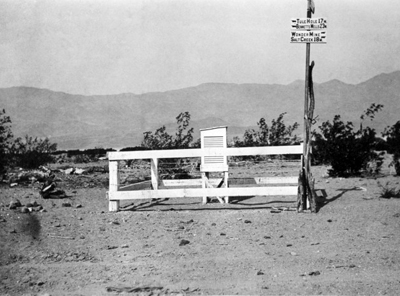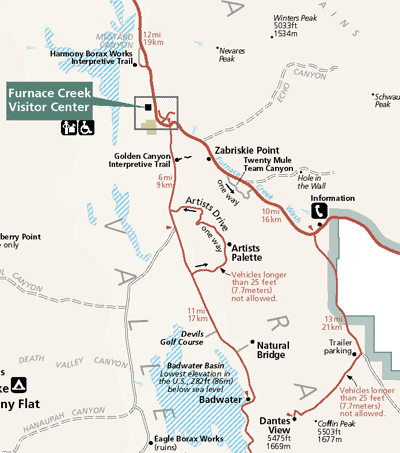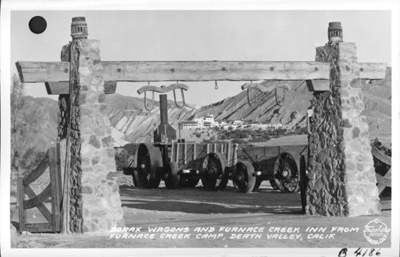Furnace Creek Ranch History
(1) Greenland Ranch Supplies Food to Borax Workers and Serves as Mule Train DepotThe industrial phase of Death Valley history began with the discovery of borax there by Aaron and Rose Winters and the subsequent purchase of their claims by William T. Coleman in the early 1880s. After establishing a location for his open-air borax refinery about 1-1/2 miles north of the mouth of Furnace Creek, Coleman next addressed the need for a supply point to provide essential provisions for his mules and for his workmen at this plant and at his Amargosa works. [36] A logical place for this operation was the spot near the mouth of Furnace Creek Wash that had been homesteaded in the 1870s by one "Bellerin" Teck, an unknown and still vastly mysterious figure who live there for a short while, raised alfalfa and barley, and then seemingly disappeared from the annals of history.
The ranch consisted of a large adobe house with a wide northern veranda, and was first referred to as "Greenland" and occasionally as "Coleman." It was given its present name by the Pacific Coast Borax Company sometime after 1889. It is recorded that about 1879 Coleman, enjoying a certain affluence at this time, sent to Italy for gardeners to supervise agricultural development of the site. At great expense the soil was scientifically fertilized and various types of trees planted in the resulting dark and heavy loam. A half-acre pond was constructed and water from the Funeral Range was diverted from Travertine Springs to the ranch via a stone-lined ditch to irrigate thirty or forty acres of alfalfa and trees.
With about forty men actively employed at the borax works, and considering its vital function as a terminus station for the twenty-mule teams, where wagons could be repaired while men and animals enjoyed the luxury of a few days' leisure after their exhausting round-trip haul to the railhead, the ranch became an important center of operations. Under the guardianship of James Dayton and by dint of constant irrigation, livestock flourished in this barren desert, as did the growth of melons, vegetables, alfalfa, figs, and cottonwoods. The presence of water, shade trees, and grass in the area led to temperatures that usually ranged from eight to ten degrees cooler than elsewhere in the valley, and by 1885 the farmstead was rich in alfalfa and hay, while cattle, hogs, and sheep were supplying fresh meat for the tables of the Harmony borax workers.
(2) Pacific Coast Borax Company Takes Over Ownership and Ranch Becomes Friendly Oasis for Prospectors
The promotional possibilities offered by this cool oasis greatly appealed to Coleman, who at one point envisioned eventual establishment of a resort here. These dreams were rapidly deflated by the downward spiralling of his economic fortunes, which ultimately forced him to mortgage all of his holdings to Francis M. ("Borax") Smith and eventually lose them all to that great entrepreneur in 1890. Smith's stewardship began with the closing of both the Harmony and Amargosa borax works, his business efforts now being concentrated solely on his new mine at Borate. Jimmy Dayton, however, remained as watchman for the borax plant and caretaker of the ranch farm. Some idea of the style of life he led here can be gained from the following account of a visit to his headquarters:
-
He [Dayton] cooks his food in a frame kitchen and sleeps in an adobe bedroom. The walls of the bedroom were plentifully adorned with lithographs of young women, such as the tobacco-makers distribute gratis. Two shotguns and a rifle stood in one corner. A prospector was keeping the house for Dayton during the latter's absence, and every day I was there he killed, with the shotgun, numbers of duck, teal, butter-ball and mallard, which, in their journey from the north, came down to see what kind of feed could be had on the alfalfa meadows, and in an artificial, half-acre fish pond at one corner of the oasis. The rifle is sometimes used on the sheep in the Funeral range to the east . . . . Had we wished, we might have had carp from the pond, which was stocked some years ago, while flocks of
quail
were seen in the brush about the fields. [37]
Dayton served as caretaker and foreman of the ranch for about fifteen years, until his death in 1900. By the early years of the next century one Oscar Denton had taken over his duties, and with the help of local Indians was continuing to raise alfalfa and figs. After the turn of the century, the ranch was the scene of increased activity as dozens of prospectors combed the nearby ranges as part of the new southern Nevada mining boom centering around Tonopah and Rhyolite and their environs. The ranch was the resting place where these "desert rats" could lounge beneath the trees and bathe in the ditches white awaiting supplies ordered to be sent to Denton from Death Valley Junction. This was the place to which everyone went whenever loneliness overcame him and he needed human association and conversation. The old time Death Valley prospectors traveled alone, their burros the only companionship they had. Without Furnace Creek Ranch, Oscar Denton, and the Panamint Indians, Death Valley would have been intolerable. [38]
(3) Precautions Necessary Because of Unbearable Summer Heat
There were, however, a few drawbacks to life at this veritable shangri-la, not the least of which was the intense °summer heat. The 1883 report of the California state mineralogist attempted to describe the difficulties experienced by residents of the Furnace Creek area:
The atmosphere presents many peculiar features, among others, causing a feeling of lassitude and weariness and an intense thirst upon very slight exertion. Many of those who have been for a month or more residents of the valley complain of an affection [affliction] of the eyes, which become sore and weak . . . . During the visit of Mr. Hawkins, in May and June, 1882, almost every afternoon a burning wind, fierce and powerful, sprang up, blowing articles of considerable weight some distance, and hurling the coarse, hot sand with such force as to lacerate the face when exposed, the men being frequently obliged to wear veils and goggles. The heat was severe, the thermometer averaging from 95° to 100° Fahrenheit in the shade . . . . The stones and cement became so hot by ten o'clock A. M. that work was suspended until late in the afternoon, and at night the men frequently rolled themselves in thoroughly wet blankets in their endeavors to keep cool. [39]
A New York reporter who visited the spot in the early 1890s presents a vivid description of the consequences of the environment and the effort necessary to survive the extremes in temperature:
-
While making the ditch which supplied the ranch with water, J. S. Crouch and O. Watkins slept in the running water . . . . Philander Lee . . . while at work on the ranch, regularly slept in the alfalfa where it grew under the shade of some willows and was abundantly irrigated.
Other effects of the arid air are found in the utter ruin, within a few days, of every article of furniture built elsewhere and carried there. . .
Meat killed at night and cooked at 6 in the morning had spoiled at 9 . . . . Eggs are roasted in the sand. [40]
The products of the ranch were being continually improved over the years. In 1906 it was noted that
-
One of the most wonderful sights in Death Valley is the Furnace Creek Ranch, owned by the Pacific Coast Borax Company. They can raise almost anything there. They have fresh eggs and milk the year round. The weary prospector may put his hungry burro in the corral, and fill him up with good alfalfa for 35 cents per night. There is plenty of water, over fifty inches running in the ditch, and more in a pipe line. [42]
(4) Indian Population
One interesting aspect of life on the ranch was the Indian population that gathered there. Furnace Creek had habitually been a social center and contact point for three linguistic groups: the Shoshonis from the north, the Southern Paiutes from east of the valley, and the Kawaiisu from southern Death and Panamint valleys. [44] After John Spears had stopped at the ranch in 1892 he described the following visit by a neighboring Indian and gives some indication of their lifestyle:
-
While at the ranch it was visited by a native sportsman--a little black, dirty Paiute. He was dressed in cast-off clothing of white men, and was armed with a bow and three arrows. The bow was of juniper, backed with raw sinew, and the arrows were of reed, tipped with juniper. They were effective against rabbits, rats, and lizards, and so satisfactory to the Paiute sportsman . . . . The Indians had burned some acres of mesquite and brush along Furnace Creek in their hunting for rabbits and rats. There is very little meat about them, but everything is fish that comes to the Paiute net, including the kangaroo rats. [45]
The Indians employed as ranchhands were described by a desert photographer, Clarence Back, in 1907 as being extremely uncommunicative, often not speaking to their employer for weeks.
In 1910 George Bird Grinnell described Indian women and children in April trapping rodents and lizards in the mesquite thickets around the ranch, catching them in deadfall traps or nooses and boiling them in kettles. [46] In 1922 Edna Perkins described the "Panamint" Indians living at the ranch in this manner:
The Indians . . . are employed as laborers, when they will work. The superintendent, a vigorous, silent Scotchman, was extremely pessimistic about them. While we were there they had "the flu" and all we ever saw them do was sit around the corral waiting for supplies to be handed out. The women and girls, with heavy melancholy faces, gathered and stared at us. They stared with the stolid curiosity of cattle, not like burros who twitch their ears saucily, though they have the burro's reputation for thievishness. The superintendent kept everything under lock and key. The only Indian who showed a sign of life was an old fellow who prowled around with a gun after the birds and wild ducks that make the ranch a resting-place in their flights across the desert. We were told that there was only one gun in the whole encampment and that the younger men hunted with bows and arrows. Most of them looked stunted and their faces were wrinkled like the skins of shrunken, dried-up apples, as though the valley were taking toll of the generations of their race. [47]
(5) Ranch Contemplated as Health Resort
In the fall of 1907 rumors were circulating to the effect that Borax Smith was now entertaining visions of developing his Furnace Creek ranch as a winter resort, and was even contemplating extending a branch line of the Death Valley Railroad to provide access to both his borax deposits along Furnace Creek Wash and the ranch. This plan was amplified somewhat in early 1908 into establishment of a health resort for persons suffering from pulmonary disorders and related afflictions. The climate here, especially the density of the air, its increased pressure, and the higher percentage of oxygen, were all thought to have a curative effect on such diseases. It was said that a large sanitarium plus a hotel and bathhouse would be erected.
By February 1907 the Furnace Creek ranch was described as "a great stretch of green--a magnificent spread of emerald in a grimy, desolate bed of shale and sand." [49] Three hundred acres were reportedly under cultivation, with experiments successfully carried out in growing alfalfa grasses, vegetables, melons, apples, and pears. [50]
(6) Official Weather Station
Back in April 1890 Greenland Ranch had been selected by the Weather Bureau of the Department of the Interior as an official weather station, and it had been duly fitted with rain gauges and a thermometer. In 1922 the U.S. Weather Bureau established a substation here, tests run over the previous ten years having shown that this was the hottest region in the United States. The average of the extreme maximum temperatures reported since 1911 had been 125°F. Almost daily during June to August at the ranch temperatures of 100°F. or higher occurred, with the temperature of 134°F. on 10 July 1913 believed to be the highest natural-air temperature ever recorded with a standard thermometer exposed in the shade under approved conditions. Even the water providing irrigation for the ranch has a temperature of between 74° to 100°F. During this time period the ranch was experimenting with poultry raising in addition to a lucrative business in the production of dressed meat. [51]
Furnace Creek Ranch
(7) Date Growing Introduced
The growth of dates was introduced to the Furnace Creek ranch about 1921 or 1922, supposedly at the behest of Pacific Coast Borax Company officials who suggested it as an added source of revenue. This planned extension of the date industry in a most unexpected direction was arrived at after extensive research conducted by Dr. Walter Swingie, principal originator of the date industry in America. The man who had supervised the successful government date operations in the Coachella Valley of California, Bruce Drummond, was engaged to direct the Furnace Creek venture. In addition to some California native "wild date palms" and specimens of a Canary Island native, selected samples of the ° Deglet Noor (Date of Light) palm were also set out. This latter tree is not native to the New World but was introduced from Africa in 1898. Of the several varieties of soft dates experimented with by the government in these initial years, it quickly proved the hardiest, and now comprises most of the Ranch's present large grove. The site's comparative isolation made it ideal for growing pest-free. stock. In the 1930s fertilizer was trucked in from the Pahrump ranch southeast of Death Valley Junction to be applied to the palms. One major obstacle to their growth, the fact that were were no bees in the, valley, necessitated hand pollination of the trees. Dates have been the principal product of the last fifty years, the other experiments with winter vegetables, cotton, and citrus trees enjoying lesser success. Excellent crops are produced, and the fancy dates are shipped to market and are also available in gift packages at the ranch. [52] During the 1920s the ranch also produced two hundred tons of alfalfa annually that were fed to a herd of high-grade beef cattle that were in turn fed to the men at Ryan.
(8) Ranch Turned into Tourist Resort
In 1930 when the hotel at Ryan closed, the borax company felt that some type of accommodations should be offered in the valley that would be less expensive and of a more relaxed sort than were found at Furnace Creek Inn. Because of their ranch's abundance of water and its level building site, it seemed the logical place for such an undertaking. Eighteen tent houses that had formed the construction camp at the inn were moved down to the site. To these were added several workers' bungalows from the just-completed Boulder (later Hoover) Dam, which were moved to the site and remodeled for tourist use. A 16 x 36-foot boarding house and cabins (now removed) from the abandoned Gerstley Mine near Shoshone were also used to bolster the accommodations.
The Ranch first opened its doors for business in 1933, and for two years the wives of the Ranch foreman and mechanic operated the hotel, which underwent a continual program of enlargement and expansion over the next ten years. The balance of the cabins were built in the period from 1935 to 1939, with the lobby, store, and dining room constructed in 1934-35. In 1936 a building originally erected for drying dates was being used as a schoolhouse for fifteen or twenty elementary schoolchildren. (Also in that year the Ranch was the terminus again for a commemorative run by the U.S. Borax Co. twenty-mule team.) The recreation hail was built in 1936, the kitchen enlarged in 1952, and the office and swimming pool added during 1951 to 1952. [53] orchard
Illustration 268. Date orchard at Furnace Creek Ranch at harvest time. Photo by George Grant, 1939, courtesy of DEVA NM.
Furnace Creek Ranch
The advent of World War 11 not only postponed a $150,000 building program for the Ranch planned by the Pacific Coast Borax Company's London offices, including a projected new lobby, dining room, coffee shop, and kitchen, plus new parking facilities and fifty new cabins, but also resulted in a shutdown of services. By the time this took place, however, the Ranch did have accommodations for 350 people, plus a nine-hole all-grass golf course that had been added in 1930 for the Inn guests but that was used equally by Ranch customers. After the three-year hiatus, the Ranch, Inn, and Amargosa Hotel reopened in 1945 and were run for ten years by Charles Scholl. In 1955 they were all leased to the Fred Harvey organization, which decided to concentrate its operations within the valley, resulting in sale of the Amargosa Hotel in 1959. The newest units at the Ranch, located alongside the golf course, were completed in 1975, and' other recreational facilities, such as tennis courts, were completed in 1977. [54]
The highlight of a tour of the Ranch today is a visit to the borax museum, begun in the 1950s as an educational opportunity for guests. The old borax office building from Twenty-Mule-Team Canyon was moved to the Ranch around 1954, and its interior filled with exhibits on mining, Indian populations of the valley, and railroad history. Back of this structure is an outdoor museum exhibit of antique vehicles and mining equipment, including an old steel-tired buckboard belonging to Borax Smith, an early stagecoach used on the run between nearby mining towns, and other assorted wagons, plus a stamp, a ball mill, a whim, the Death Valley Railroad Engine No. 2, and miscellaneous souvenirs such as the small Death Valley Chuck-Walla printing press rescued from Greenwater and the original twenty-mule-team barn moved up from Mojave. On one side of the entrance to the Ranch is Old Dinah--the high-wheeled oil-burning steam tractor used on the Borate to Daggett route for a year or so and then put into service hauling between Beatty and the Keane Wonder gold mine in the Funeral Range. After its twenty-year abandonment in Daylight Pass, it was towed down to the Ranch in 1932 to be added to the Furnace Creek Ranch museum collection. On the other side of the entrance are some borax and water wagons.
b) Present Status
Today this Fred Harvey-owned resort offers simple wooden cabins, fancier pool- and golf-side rooms, and deluxe motel units. Opportunities for recreation are provided, including a beautiful golf course, a swimming pool, and horseback riding, and also available are an outdoor restaurant, a coffee shop, a cafeteria, a general store selling food, books, and souvenirs, a post office, and an airstrip. Trailer and camping sites are located nearby. The resort's location is enhanced by the presence of the National Monument Visitor Center immediately to the north.
c) Evaluation and Recommendations
The site on which Furnace Creek Ranch is now located is one of the most historically significant spots in the monument. Its location near the mouth of Furnace Creek--a steady water supply throughout the year--made possible its development as a farm operation as early as the 1870s. Prior to this the area was probably visited frequently by members of the surrounding Indian populations to the north, south, and east. Little is known of the extent of this early aboriginal activity or of the life of the first Anglo homesteader on the site. The Furnace Creek ranch gained major importance as the supply 'point for the Harmony and Amargosa borax works and as the northern terminus of the twenty-mule-team wagon route between Harmony and the railhead at Mojave. Perhaps its most important contribution, if the many prospectors and other desert travelers in the area during the early 1900s could be polled, was its service in providing shade, water, and some semblance of social amenities in a harsh, often brutal, environment, and its status as a meeting-place where fellow "desert rats" could get together and socialize, swapping stories and dreams before embarking again on the never-ending quest for riches. Initially producing mostly alfalfa and hay for stock, the ranch later raised and dispersed beef to feed workers at the nearby borax camp of Ryan.
An interesting sidelight to the ranch's history would be a determination of the amount of influence it exerted on the development of the various Indian groups who either resided at or visited the ranch. One would gather from the rather scathing comments on the native inhabitants presented earlier in this section that hardly any mingling of the races occurred, but it must be remembered that these observations were made by one-time visitors to the area, and fairly sophisticated ones at that. The more mundane and less "cultured" mining community undoubtedly had daily, and thus more influential, contact with the native population.
The ranch's later evolvement into a tourist resort is not considered notable because the tourist industry had already been given its start by the construction of Stovepipe Wells Hotel and then of Furnace Creek Inn. Most of the early buildings of the complex that were architecturally significant because they were a curious mixture of old mining cabins and construction bungalows imported from surrounding desert communities have long since been removed. The present structures date from the 1930s on. The site should be provided with an interpretive marker presenting highlights of the ranch's early days and pointing out its significant role in Death Valley history.
from;
NPS: Death Valley Historic Resource Study
A History of Mining - Linda Greene
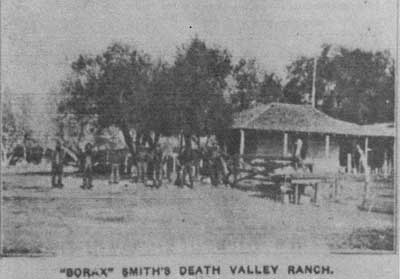
Illustration 265. Pacific Coast Borax Company's Furnace Creek Ranch, about 1909. From Rhyolite Herald Pictorial Supplement, March 1909.
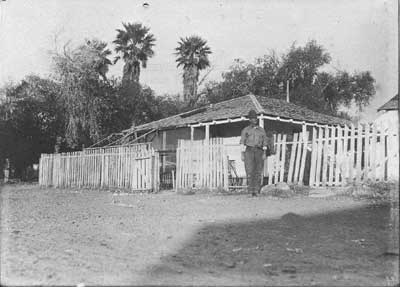
Illustration 266. Furnace Creek Ranch, about 1915.
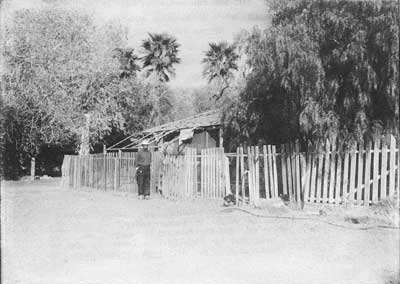
Illustration 267. Furnace Creek Ranch, 1916. From Dane Coolidge Collection, courtesy of Arizona Historical Foundation.
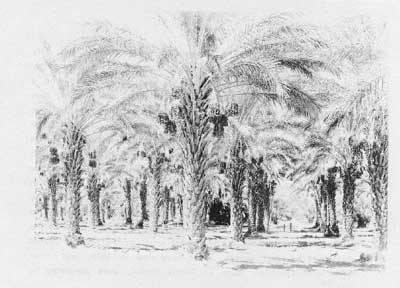

Illustration 269. Furnace Creek Ranch entrance. Photo by Linda W. Greene, 1978.
